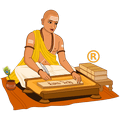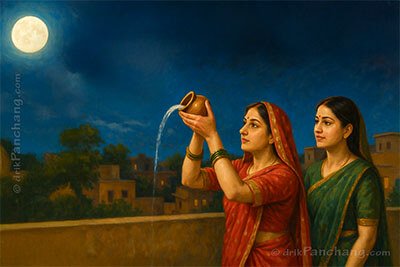
























 Moonrise on Purnima Upavasa Day - 08:04 PM
Moonrise on Purnima Upavasa Day - 08:04 PMNotes: All timings are represented in 12-hour notation in local time of Fairfield, United States with DST adjustment (if applicable).
Hours which are past midnight are suffixed with next day date. In Panchang day starts and ends with sunrise.
In Hinduism, the Purnima Vrat is considered highly important. This fast is observed on the Purnima Tithi of the Shukla Paksha every month. According to the Battisi Purnima Vrat described in the Bhavishya Purana, the fast should begin from the full moon of the months of Margashirsha, Magha, and Vaishakha, and be concluded on the Purnima of Bhadrapada or Pausha month. This fast is also called the Dvatrimshi Purnima Vrat. Observing this fast is believed to bring all forms of happiness, good fortune, and progeny.
The Purnima Tithi is also considered very significant for worshiping Lord Vishnu. On this day, the Lord Chandra appears in His full form. Worship of the Lord Chandra on this occasion is believed to be highly beneficial. Scriptures such as Skanda Purana, Padma Purana, Narada Purana, Bhavishya Purana, and the Mahabharata mention the observance of this fast. This auspicious fast is said to destroy sins, increase merit, and purify the mind.
On the day of the Purnima Vrat, if possible, take a bath in a sacred river in the morning and perform Tarpan. Otherwise, bathe at home using water mixed with Gangajala. After bathing, take a Sankalpa for the fast - "I will observe the Dvatrimshi Purnima fast for the well-being, prosperity, and happiness of my family. To ensure the completion of this fast without any hurdles, I will worship Lord Ganesha and perform Kalash Pujan."
This completes the simple and brief procedure of the Purnima Vrat.
There are regional differences regarding food during this fast. Generally, people consume water, fruits, and simple vegetarian food made with milk. Many people observe a water-only fast. All types of grains, spices, tobacco, tea, and coffee are considered tamasic and are prohibited during this fast.
The timing to break the fast depends on the type of fast being observed. However, in the most common form, the fast is broken in the evening after offering Arghya to the Lord Chandra. Before breaking the fast, one should donate food, clothes, Ghee, sesame, rice, etc., to a Brahmin as per their capacity. Then, after serving food to the Brahmin with a Dakshina, the devotee should break the fast by consuming fruits etc.
According to the Bhavishya Purana, the Udyapana, i.e., conclusion ceremony of this fast should be done on the Purnima of Jyeshtha or any other auspicious month. The simple procedure is as follows.
First, clean the ground and draw a Chowk. Place an earthen pot known as Kalash in the centre and cover it with a bamboo container. According to one's capacity, have an idol of Shri Uma-Maheshwara made of half or one Pal of gold. Install this idol with a bull on the bamboo container. Then perform a sixteen-step worship of Lord Shiva. Conduct devotional singing and night vigil. The next morning, after bathing, perform a Havana by the Shiva Panchakshara Mantra. Offer 108 Ahuti(s), i.e., oblations with sesame, barley, and Ghee. After completing the Havana, worship the Acharyas. Wrap thirty-two types of fruits in cloth, place a lamp over rice grains, and give them to a priest while chanting "Vanakam Tava Tushtayartham Dadami Girijapate."
After that, offer meals to thirty-two Brahmins, thirty-two women, and other priests with all six types of gravies. Scriptures prescribe donating a cow with a calf to a priest during this ceremony, but if one is not able, then donate as much as possible and receive blessings. Finally, complete the Havana with the final offering called Purnahuti. After feeding the Brahmins, the remaining offerings may be consumed by the devotee. This concludes the brief description of the Udyapana Vidhi of the Purnima Vrat as described in the Bhavishya Purana.